
Dinocephalians are a clade of large-bodied early therapsids that flourished in the Early and Middle Permian between 279.5 and 260 million years ago (Ma), but became extinct during the Capitanian mass extinction event. Dinocephalians included herbivorous, carnivorous, and omnivorous forms. Many species had thickened skulls with many knobs and bony projections. Dinocephalians were the first non-mammalian therapsids to be scientifically described and their fossils are known from Russia, China, Brazil, South Africa, Zimbabwe, and Tanzania.

Gorgonopsia is an extinct clade of sabre-toothed therapsids from the Middle to Upper Permian roughly 265 to 252 million years ago. They are characterised by a long and narrow skull, as well as elongated upper and sometimes lower canine teeth and incisors which were likely used as slashing and stabbing weapons. Postcanine teeth are generally reduced or absent. For hunting large prey, they possibly used a bite-and-retreat tactic, ambushing and taking a debilitating bite out of the target, and following it at a safe distance before its injuries exhausted it, whereupon the gorgonopsian would grapple the animal and deliver a killing bite. They would have had an exorbitant gape, possibly in excess of 90°, without having to unhinge the jaw.

Biarmosuchus is an extinct genus of biarmosuchian therapsids that lived around 267 mya during the Middle Permian period. Biarmosuchus was discovered in the Perm region of Russia. The first specimen was found in channel sandstone that was deposited by flood waters originating from the young Ural Mountains.

Biarmosuchia is an extinct clade of non-mammalian synapsids from the Permian. Biarmosuchians are the most basal group of the therapsids. They were moderately-sized, lightly built carnivores, intermediate in form between basal sphenacodont "pelycosaurs" and more advanced therapsids. Biarmosuchians were rare components of Permian ecosystems, and the majority of species belong to the clade Burnetiamorpha, which are characterized by elaborate cranial ornamentation.

Inostrancevia is an extinct genus of large carnivorous therapsids which lived during the Late Permian in what is now European Russia and Southern Africa. The first-known fossils of this gorgonopsian were discovered in the Northern Dvina, where two almost complete skeletons were exhumed. Subsequently, several other fossil materials were discovered in various oblasts, and these finds will lead to a confusion about the exact number of valid species in the country, before only three of them were officially recognized: I. alexandri, I. latifrons and I. uralensis. More recent research carried out in South Africa has discovered fairly well-preserved remains of the genus, being attributed to the species I. africana. An isolated left premaxilla suggests that Inostrancevia also lived in Tanzania during the earliest Lopingian age. The whole genus is named in honor of Alexander Inostrantsev, professor of Vladimir P. Amalitsky, the paleontologist who described the taxon.
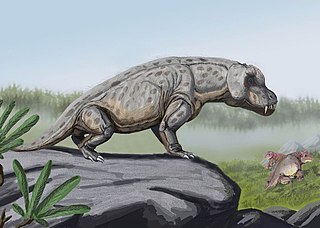
Anteosaurs are a group of large, primitive carnivorous dinocephalian therapsids with large canines and incisors and short limbs, that are known from the Middle Permian of South Africa, Russia, China, and Brazil. Some grew very large, with skulls 50–80 centimetres (20–31 in) long, and were the largest predators of their time. They died out at the end of the Middle Permian, possibly as a result of the extinction of the herbivorous Tapinocephalia on which they may have fed.

Dvinia is an extinct genus of cynodonts found in the Salarevo Formation of Sokolki on the Northern Dvina River near Kotlas in Arkhangelsk Oblast, Russia. It is the only known member of the family Dviniidae. Its fossil remains date from the Late Permian and were found with Inostrancevia, Scutosaurus and Vivaxosaurus.

Ericiolacerta is an extinct genus of small therocephalian therapsids from the early Triassic of South Africa and Antarctica. Ericiolacerta, meaning "hedgehog lizard", was named by D.M.S. Watson in 1931. The species E. parva is known from the holotype specimen which consists of a nearly complete skeleton found in the Lystrosaurus Assemblage Zone within the Katberg Formation of the Beaufort Group in South Africa, and from a partial jaw found in the Lower Triassic Fremouw Formation in Antarctica. Ericiolacerta was around 20 centimetres (7.9 in) in length, with long limbs and relatively small teeth. It probably ate insects and other small invertebrates. The therocephalians – therapsids with mammal-like heads – were abundant in Permian times, but only a few made it into the Triassic. Ericiolacerta was one of those. It is possible that they gave rise to the cynodonts, the only therapsid group to survive into post-Triassic times. Cynodonts gave rise to mammals.

Anteosaurus is an extinct genus of large carnivorous dinocephalian synapsid. It lived at the end of the Guadalupian during the Capitanian stage, about 265 to 260 million years ago in what is now South Africa. It is mainly known by cranial remains and few postcranial bones. Measuring 5–6 m (16–20 ft) long and weighing about 600 kg (1,300 lb), Anteosaurus was the largest known carnivorous non-mammalian synapsid and the largest terrestrial predator of the Permian period. Occupying the top of the food chain in the Middle Permian, its skull, jaws and teeth show adaptations to capture large prey like the giants titanosuchids and tapinocephalids dinocephalians and large pareiasaurs.

Sauroctonus is an extinct genus of gorgonopsian therapsids who lived during the end of the Middle Permian in what is now European Russia. The first fossils, discovered in Tatarstan, were initially believed to belong to a new species of the South African genus Arctognathus. The taxon was designated as such until 1940, when it was assigned to the genus Inostrancevia by Ivan Yefremov, before being definitively classified in a separate genus erected by Alexey Bystrow. The most complete, known fossils of S. progressus include cranial and postcranial elements, currently all recorded from Tatarstan. These elements show that the animal was a mid-sized gorgonopsian.
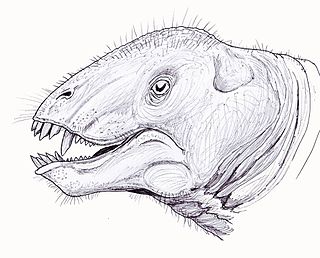
Tapinocaninus is an extinct genus of therapsids in the family Tapinocephalidae, of which it is the most basal member. Only one species is known, Tapinocaninus pamelae. The species is named in honor of Rubidge's mother, Pam. Fossils have been found dating from the Middle Permian.
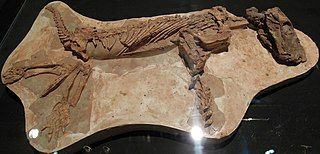
Viatkogorgon is a genus of gorgonopsian that lived during the Permian period in what is now Russia. The first fossil was found at the Kotelnich locality near the Vyatka River and was made the holotype of the new genus and species V. ivachnenkoi in 1999. The generic name refers to the river and the related genus Gorgonops—the gorgons of Greek mythology are often referenced in the names of the group. The specific name honors the paleontologist Mikhail F. Ivakhnenko. The holotype skeleton is one of the most complete gorgonopsian specimens known and includes rarely preserved elements such as gastralia and a sclerotic ring. A larger, but poorly preserved specimen has also been assigned to the species.

Styracocephalus platyrhynchus is an extinct genus of dinocephalian therapsid that existed during the mid-Permian throughout South Africa, but mainly in the Karoo Basin. It is often referred to by its single known species Styracocephalus platyrhynchus. The Dinocephalia clade consisted of the largest land vertebrates and herbivores during the early to mid-Permian. This period is often also referred to as the Guadalupian epoch, approximately 270 to 260 million years ago.

Venyukovia is an extinct genus of venyukovioid therapsid, a basal anomodont from the Middle Permian of Russia. The type and sole species, V. prima, is known only by a partial lower jaw with teeth. Venyukovia has often been incorrectly spelt as 'Venjukovia' in English literature. This stems from a spelling error made by Russian palaeontologist Ivan Efremov in 1940, who mistakenly replaced the 'y' with a 'j', which subsequently permeated through therapsid literature before the mistake was caught and corrected. Venyukovia is the namesake for the Venyukovioidea, a group of small Russian basal anomodonts also including the closely related Otsheria, Suminia, Parasuminia and Ulemica, although it itself is also one of the poorest known. Like other venyukovioids, it had large projecting incisor-like teeth at the front and lacked canines, although the remaining teeth are simple compared to some other venyukovioids, but may resemble those of Otsheria.
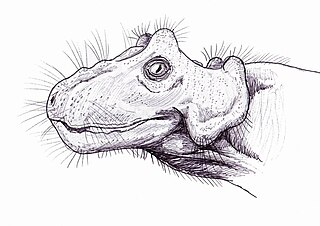
Paraburnetia is an extinct genus of biarmosuchian therapsids from the Late Permian of South Africa. It is known for its species P. sneeubergensis and belongs to the family Burnetiidae. Paraburnetia lived just before the Permian–Triassic mass extinction event.

Megawhaitsia is an extinct genus of large therocephalian therapsids who lived during the Late Permian (Wuchiapingian) in what is now Eastern Europe. The only known species is M. patrichae, described in 2008 from several fossils discovered in various oblasts of European Russia. The fossils are representative of a large animal whose skull size is estimated to be 40–50 cm (16–20 in) long.

Biseridens is an extinct genus of anomodont therapsid, and one of the most basal anomodont genera known. Originally known from a partial skull misidentified as an eotitanosuchian in 1997, another well-preserved skull was found in the Qingtoushan Formation in the Qilian Mountains of Gansu, China, in 2009 that clarified its relationships to anomodonts, such as the dicynodonts.
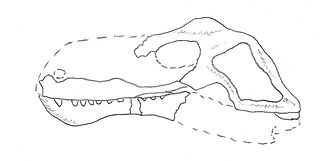
Dimacrodon is an extinct genus of non-mammalian synapsid from the latest Early Permian San Angelo Formation of Texas. It is distinguished by toothless, possibly beaked jaw tips, large lower canines and a thin bony crest on top of its head. Previously thought to be an anomodont therapsid related to dicynodonts, it was later found to lack any diagnostic features of anomodonts or even therapsids and instead appears to be a 'pelycosaur'-grade synapsid of uncertain classification.

Glanosuchus is a genus of scylacosaurid therocephalian from the Late Permian of South Africa. The type species G. macrops was named by Robert Broom in 1904. Glanosuchus had a middle ear structure that was intermediate between that of early therapsids and mammals. Ridges in the nasal cavity of Glanosuchus suggest it had an at least partially endothermic metabolism similar to modern mammals.

Tiarajudens is an extinct genus of saber-toothed herbivorous anomodonts which lived during the Middle Permian period in what is now Rio Grande do Sul, Brazil. It is known from the holotype UFRGS PV393P, a nearly complete skull. The type species T. eccentricus was named in 2011.


























